In this test our evaluation will include a new pistol that snuck up on everyone. On Tuesday, October 16, 2007, Ruger announced its SR9 9mm pistol, with an MSRP of $525. By Thursday, pistols began to arrive at retailers. By Friday, we had one to test.
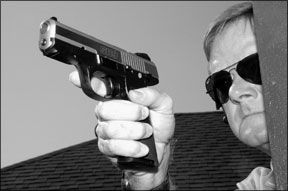
The keynote of this design was its grip similarity to the 1911, including ambidextrous thumb safeties and a choice of backstrap (flat, or palm swell design). Would sharing ergonomics and active safety features with the Browning design convince more traditional shooters to switch to a striker-fired double action pistol?
Our second pistol was also a recent entry. The $939 Heckler & Koch P30 is a new vision of the P-series pistol that features the most adjustable ergonomics yet. Distribution has been limited but we found one at Fountain Firearms in Houston (fountainfirearms.com).
Our third 9mm pistol was the $543 Springfield Armory XD9 Service Four-Inch. Lacking from a list of the XD9s features found on the company website (springfield-armory.com/xdfeatures.php) was an adjustable grip. Nevertheless, XD9 has been recognized as offering superior ergonomics, and like the SR9, the XD also shares some of the safety features found on the 1911.
How We Tested
Our formal test procedure began with firing from support at paper targets mounted 25 yards downrange. We recorded the maximum size of five-shot groups produced by a budget hollowpoint, Remington UMCs 115-grain JHP, a premium hollowpoint, Federals 124-grain Hydra-Shok round, and 124-grain FMJ rounds from Winchester USA. But we also kept a variety of additional ammunition in reserve to test the guns for reliability.
In a November 2007 test of three defensive pistols, we discovered that a balanced grip played a huge role in delivering accurate rapid-fire shots from a double-action pistol. With three guns that place so much emphasis on ergonomic design, we decided to repeat our rapid-fire test and find out which one was the fastest and most accurate at close quarters. Using a CED 7000 timer ($120, cedhk.com), we fired five two-shot strings at a distance of 5 yards onto an 8.5- by 11-inch piece of loose-leaf paper. This drill was performed once holding the gun in two hands (free style), and again holding the gun with one hand (strong hand only). In each case we looked for a total of ten hits on the paper, and nobody got an alibi run. For this drill we loaded each gun with Black Hills Ammunition 115-grain FMJ rounds. We chose this round because it was economical, reliable and frankly, the most fun to shoot. Here is what we learned.
Ruger SR9 9mm, $525
Upon first impression it is easy to see why the SR9 draws comparison to the Browning 1911. The grip had a narrow, flat profile, and the slide sported a slab-side cut with cocking serrations to the rear. The polished sides set off a matte finish on top. We located frame-mounted thumb safeties on each side, as well as a button-style magazine release.
Firing from a 4.1-inch barrel, the profile of the SR9 clearly mirrored a Commander-sized 1911. This is not the first time Ruger has copied the 1911. Post-war Bullseye competitors sought out the Ruger 22/45 pistol so that the feel of their rimfire weapon would more closely match their centerfire pistol.
Like the rimfire 22/45 pistols, the SR9 also offers less expensive practice via more economical ammunition. But packed with 17+1 rounds, the SR9 is also a serious defensive weapon. Its sister gun, the SR10, is identical but shipped with 10-round magazines to suit certain state laws. All 17 rounds in the magazine sat stowed in a trim package that did not require a thick grip or a magazine extension. In fact, the basepad of the magazine fit flush with the flat-sided grip. The magazine offered viewing holes on each side for quick confirmation of capacity. The basepad was removable.
Easily mistaken for polymer, the SR9s frame construction is glass-filled nylon. The rear face of the grip featured a ribbed insert made from soft rubber. The insert was reversible. One side rendered a flat backstrap (or mainspring housing, as it would be described on a true 1911). The reverse side formed an arched profile. We found this feature to be as useful as it was clever. The top of the grip was undercut, creating a beavertail effect. Directly above the undercut was a small frame-mounted safety. In the up locked position, the shooter could see a white dot. Lever-down safety-off status displayed a red oval on the slide. Forward of the trigger guard was a single slot Picatinny rail that fit a Surefire X200 unit perfectly.
The rear of the slide included an insert of steel covered with plastic that surrounded a striker indicator, which was visible when the gun was cocked. As we pulled the trigger, we could see the indicator move to the rear and disappear into the hole when the shot was released. This verified the SR9 as a double-action pistol. A loaded-chamber indicator sat high above the slide when a round was in the chamber. The extractor was mounted externally.
The front sight was tall with a white dot in the center. The rear unit showed two smaller white dots and was adjustable for windage and elevation. The operator changed windage adjustment by loosening the set screw and physically pushing the entire unit left or right. The shooter changed elevation by turning a screw that moved the inner portion of the unit independently up or down.
Field-stripping began with removing the magazine and locking back the slide. Looking down through the ejection port, the shooter could see the ejector. The next step was to push the ejector down and forward. The first time we tried this, we were forced to use the eraser end of a pencil as recommended in the owners manual. But after the first time, we were able to move it easily with our bare fingers. With the ejector in the release position, we easily removed the slide stop (which sat flush on both sides) by pushing it from the right side of the frame with the tip of pen or the tip of a bullet. Releasing the slide latch allowed the top end to leave the frame without touching the trigger. A captured flat wound spring surrounded the guide rod. This did away with having to compress the spring upon installation or the fear of the recoil spring jumping off and getting lost or worse, injuring the operator with a blow to the eye. Reassembly was simply a reverse of this procedure, except for making sure to press down slightly on the tab affixed to the transfer bar. Once the slide was past this point, we were able to lock back the slide, insert the slide stop, and return the ejector to its upward position. The SR9 was now ready to load.
We began our shooting session by firing a variety of ammunition. We found the supplied loading device to be almost useless. The first few times we loaded the magazine were difficult, but shortly the high-capacity magazines became more hospitable. The first characteristic we noticed was that the trigger worked better during live fire than when we tried the SR9 without ammunition. To clarify this characteristic the manufacturer sent out an email stating that, “If the (SR9) trigger is pulled WITHOUT the magazine in place (not recommended), the striker will drag underneath the spring-loaded magazine disconnect.” We also noticed that the quality of the
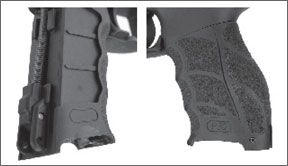
trigger pull and the result of our accuracy tests were affected by how we indexed the trigger. With the finger low on the trigger, it was too easy to drag the finger across the inside of the trigger guard. During our controlled press from the bench, we noticed varying degrees of creep. This means the finger encountersed up-and-down levels of resistance that interfered with ignition. We found that by placing the pad of the finger high on the trigger our stroke was more consistent and our scores improved.
Until we discovered the secret of keeping the finger high on the SR9 trigger, our groups were much larger and more erratic than those recorded by either the XD9 or the HK P30. We knew we were ready to shoot for record after our test shooter firing from a sandbag rest printed a sixteen round group measuring about 4.3 inches across in less than 25 seconds. The ammunition for this exercise was the 125-grain HAP round from Atlanta Arms and Ammunition (atlantaarmsandammo.com). Ultimately we were able to maintain a spread from smallest to largest five-shot group of approximately 1 inch for all three test rounds. The average sized group for all shots fired was about 2.6 inches across. Velocity and power produced by the Ruger SR9 was marginally less than what we recorded from our other test pistols.
In our action test we learned more about the Ruger SR9. Holding the gun in both hands for our free style course of fire our first shots averaged 0.86 seconds. Total elapsed time averaged 1.25 seconds. All ten shots were on the paper. Firing strong hand only, our test shooter felt awkward trying to take off the safety and maintain a stable grip. First shots took 0.89 seconds and total elapsed time was 1.44 seconds. But three shots were found off of the paper. Perhaps we should have taken more time on the first shot but here is further analysis. We think that the SR9 could have topped the time sheets if the safety levers were configured in a paddle style. This would have made it possible to establish a grip that would not change once the safety was deactivated. The strong hand thumb would also be able to ride atop the safety and assist in control. As configured the safeties prompted the shooter to slide the thumb down along the side of the grip after the lever was moved downward. The negative effect was even more pronounced during the strong hand only shots where assistance from the weak hand was not in play to help stabilize the grip.
We think it is entirely possible that accuracy and speed could have been improved by not using the thumb safeties at all and maintaining a solid grip. Indeed the SR9s 8-pound trigger presents resistance equal to or more than triggers found on a number of double action only pistols including our XD9. But we do not recommend this course of action. Especially in light of the penchant for enthusiastic shooters to further reduce the weight of the trigger pull. Better, Ruger should offer thumb safety levers that contribute to safe operation and performance, too.
In terms of reliability we noticed that when firing some of our 147-grain rounds the slide did not fully return to battery. The SR9 definitely favored ammunition that offered greater slide velocity. One positive regarding this malfunction was that it showed that the SR9 will not fire out of battery even when the slide was within 0.05 inch of closing.
Heckler & Koch
P30 V3 9mm, $939
The Heckler & Koch P30 pistol is very similar to the P2000 design we tested in the November 2007 issue. In fact, a P2000 owners manual was shipped with our P30. The P2000 is available in calibers 9mm, .40 S&W, and .357 Sig. The P30 is available only in 9mm at this time. The P2000 was HKs first pistol with a universal Picatinny accessory rail molded into the frame. Whereas the P2000 offered a single slot for mounting, the P30 is far more generous with four cross hatches beneath its dustcover. In our November tests we found that choosing the correct size backstrap made all the difference especially when firing off hand. The P30 not only offers three alternate backstraps but a pair of matching side panels also marked small, medium and large. Applying the alternate panels to the P30 was easier than working on the P2000 because the backstrap on the P30 did not hold the mainspring in check. This meant that we didnt have to fight with compressing the mainspring while seating the roll pin that locked the panels into place.
The grip surface of the P30 offered graceful contours such as a palmswell and gentle finger grooves on the front strap. Whereas the magazine basepad of the P2000 completed the grip the P30s fifteen round magazine offered a flush fit. The grip surface was
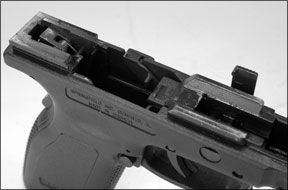
stippled with a texture that was both visually pleasing and functional. The trigger guard was squared and oversized. Magazine release was via paddles that fit into the rear of the trigger guard available from both sides of the pistol. We noticed that without a magazine in place the paddles moved upwards and interfered with the trigger finger when dry firing. The slide release lever was also ambidextrous with contact point directly above the center of the grip. The left side lever acted as the slide stop and once aligned with the proper relief was removable. This unlocked the slide from the frame. Underneath the top end the tail section of the guide rod played a part in locking and unlocking the barrel. A flat wound recoil spring was captured on the guide rod as was a nylon ring that acted as a shock buffer. The slide itself showed cocking serrations front and rear. Luminous three dot night sights were was dovetailed into place at both ends. The rear unit was adjustable for windage only via drift.
The HK P30 is a hammer ignition design. The V3 system decocker lever was positioned on the rear face of the slide to the left of the hammer. This made for decocking and holstering in one swift motion. For right-handed shooters decocking with the gun held on target was best achieved with the weak hand thumb. With the gun held in only one hand shifting the strong hand thumb to the decocker created a moment of instability. Left handed shooters will
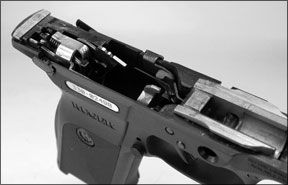
find this arrangement more awkward because the thumb of either hand will have to cross over the tang of the cocked hammer to reach the decocker. An LEM version of the P30, (wherein the trigger is a hybrid of double to single action without the necessity of an external decocker), would likely be a better choice for true ambidextrous operation. Currently the P30 is available only with the V3 decocker action.
From the shooting bench the P30 had an advantage over our other pistols. By firing all our shots single action only the operator was able to work with a more refined trigger than either the XD9 or SR9 had to offer. The P30 turned in the best overall performance firing the Federal Hydra-Shok ammunition with all groups measuring less than two inches across. If the ability to fire single action was an advantage at the bench then the transition from double to single action during our rapid-fire test was an obstacle. In our freestyle segment we averaged a 0.83 second first shot and 1.25 seconds for the total elapsed time. All shots were on target. Firing the drill strong hand only our average elapsed times were 0.89 and 1.48 respectively. But three shots were off target. We accept that a pistol with a Traditional Double action transition takes more time to learn than a pistol with only one trigger press. But just like in our tests of the P2000 we found that ergonomics produced by one set of grip panels favored shooting from a sandbag rest and another combination was better suited to shooting off hand. Not satisfied with the results of our action test we decided to experiment with mixing and matching backstrap and side panels. By applying the medium side panels and the large sized backstrap our test shooter was able to improve to a perfect score with faster first shots and shorter total elapsed times.
Springfield Armory
XD9 9mm, $543
The XD series has been a gold mine for Springfield Armory. Looking for a way to compete with Glock, Springfield found a pistol being produced primarily for the police in Croatia. Since buying into the manufacturer the XD lineup has grown to include subcompact and 5-inch tactical models in a variety of calibers including .45 ACP. But our basic black XD9 Service model Four-inch was pretty close to the original Croatian gun that first drew their attention. In European countries it is not unusual for police to work with a dog on a leash. That is one reason why many Euro-pistols favor single-hand operation.
The XD9 is a simple pistol. It has a polymer frame with an accessory rail in front of the trigger guard and button magazine release available from both sides of the pistol. There was no active mechanical safety that switches the gun off or on, but there was a lever located in the center of the backstrap that must be compressed for the gun to fire. There is also a lever inside the face of the trigger that must be compressed to clear the striker. The slide was topped with three-dot sights dovetailed into place front and rear. Cocking serrations adorn the slide fore and aft. Field-stripping begins with removing the magazine and locking the back the slide. This all but guarantees the chamber is empty. A latch on the left side of the frame is rotated clockwise 90 degrees. The slide can now be released, but before the slide can be completely removed, the trigger (with the grip safety compressed) must be pulled to the rear. Under the slide we found a dual-spring plunger-style guide rod and the barrel.
When we measure the circumference of the grip we list the maximum number. We wrap the measuring tape around the widest part including any palm swell or undulation in the grip. But it can be argued that the most important dimension of the grip is the circumference covered by the thumb and middle finger. This is the strongest point of support and control supplied by the human hand and it is here that the XD9 excelled in providing a balanced grip.
Loading the pistol for our bench session two additional safety features became apparent. A lever atop the slide leading from the rear edge of the barrel hood showed that a round was in the chamber. A silver pin poked through the rear face of the slide to show the striker was cocked. Of controversy is the matter of whether or not the XD is a double-action or single-action pistol. Once the striker is ready to be launched pressure on the trigger results in a very small rearward movement of the striker before it was released toward the primer.
From the bench we were able to achieve an average five-shot group measuring just 2.2 inches with both our hollowpoint defense loads. Our $18 per 20-round Federal Hydra-Shok loads showed less variation in group size than our $15-per-hundred-round Remington budget ammunition but each round produced sub-2 inch groups. The XD9 finished second firing the Winchester rounds.
Given the short smooth trigger and the ease of control from the grip, the XD9 was the top performer in our action tests. Average elapsed time freestyle was 0.75 seconds to the first shot and 1.15 seconds in total time respectively. All shots were found on paper and the consistency of our first shot times bears mentioning, (in order, 0.79, 0.75, 0.75, 0.73, 0.73 seconds). Strong hand only shooting was slower, (0.84 seconds first shot, 1.47 seconds total elapsed time). But the XD9 was the only gun with which we completed the action test without a single miss.
SPRINGFIELD-XD9-SERVICE-1207.pdf
GUN-TESTS-REPORT-CARD-HAND-1207.pdf




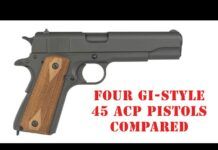
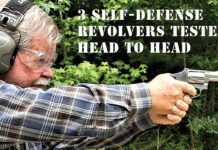


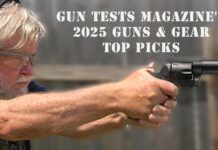

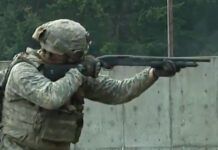


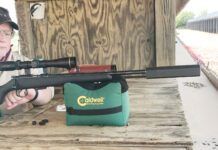





I’m a long time 1911 Fan in .45 ACP. But, with the development and advances in 9mm Ammunition, I decided to “downsize” to a 9mm Pistol. I searched long and hard to find the right Pistol for my EDC. I finally decided on the Heckler & Koch P-30, and have been Extremely happy with my choice.
I wanted a hammer fired piece, and the adjustability of the side and backstrap were enough to seal the deal. This pistol is more accurate than I am, and it’s a dream to shoot, being one of the most ergonometric guns I’ve ever shop.
Yes, I still love my 1911s, but for EDC, this H&K fills the bill.